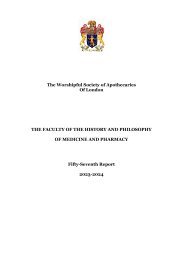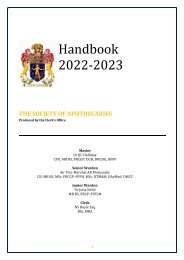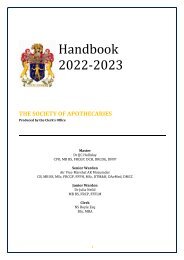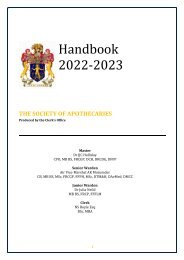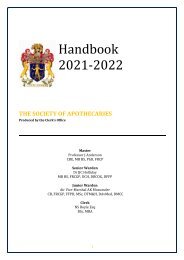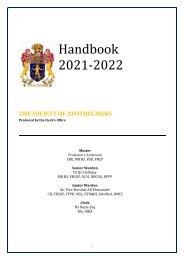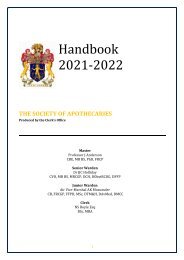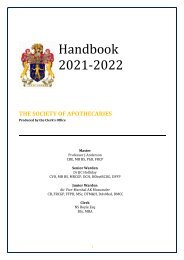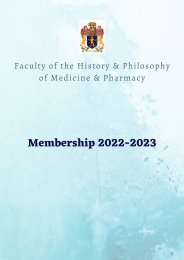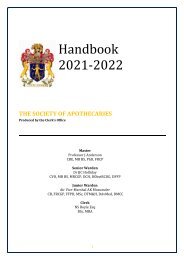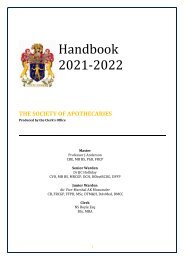You also want an ePaper? Increase the reach of your titles
YUMPU automatically turns print PDFs into web optimized ePapers that Google loves.
gained her LSA in September 1865, and so became the first openly female recipient of a medical<br />
qualification in Britain. Ronald Ross, who in 1902 became the second Nobel Prize winner in<br />
Medicine, obtained his Licence in January 1881.<br />
The title of the <strong>Society</strong> qualification was altered by statute in 1907 to become The Licence in<br />
Medicine and Surgery of the <strong>Society</strong> of Apothecaries (LMSSA). Examination for the Licence is<br />
currently in abeyance. The Act of 1815 also gave statutory powers to the <strong>Society</strong> to examine and<br />
grant a certificate called Assistant to an Apothecary, today’s Pharmacy Technician. This qualification<br />
finally ceased to be offered in January 1998.<br />
The <strong>Society</strong>’s role in medical education is also reflected in the range of specialist postgraduate<br />
diplomas that it pioneered. In 1928 it was the first body to introduce a qualification in Midwifery:<br />
the Mastery of Midwifery. This led later to the formation of the Royal College of Obstetricians and<br />
Gynaecologists. The Diploma in Industrial Health of 1946 later resulted in the founding of the<br />
Faculty of Occupational Medicine. One of the most recent diplomas, the Medical Care of<br />
Catastrophes, was encouraged by the Royal Army Medical Corps, and the Diplomas in Genitourinary<br />
Medicine and HIV Medicine are compulsory for those wishing to progress in those specialties. At<br />
present, the <strong>Society</strong> examines seven different postgraduate diplomas.<br />
Apothecaries’ Hall<br />
When the Apothecaries separated from the Grocers in 1617, the newly founded <strong>Society</strong> met in<br />
private houses, inns, and the Halls of other livery companies to conduct its business. In 1632 they<br />
purchased the former guesthouse of the Dominican Priory, in the district known as Blackfriars. The<br />
<strong>Society</strong> immediately began a programme of improvements, furnishing and decorating the building in<br />
keeping with the status of a livery company. This Hall was destroyed by the Great Fire of London in<br />
1666, but a replacement was built on the same site between 1668 and 1672, incorporating<br />
significant sections of the Priory. The resulting Hall has remained essentially unchanged since that<br />
time, with only minor alterations. Miraculously, and through the heroic dedication of the<br />
firewatchers during the Second World War, it has survived virtually intact for more than three<br />
centuries. It is the oldest extant Livery Hall in the City and<br />
is a Grade 1 Listed Building and a Scheduled Ancient<br />
Monument.<br />
The courtyard was rebuilt in 1786 to provide warehouse<br />
accommodation for the storage of the drugs and medicines<br />
manufactured on the premises. The first laboratory was<br />
established underneath the Great Hall in 1672 and, before<br />
long, the <strong>Society</strong>’s large-scale production of drugs had<br />
become a thriving commercial enterprise which survived<br />
into the 20 th century. The client base included the Royal Navy, the Army, the East India Company,<br />
and Crown Colonies.<br />
Drugs, medical and surgical equipment, and related sundries were sold in a shop at the Hall, and a<br />
retail pharmacy was opened in 1823 with its front door on what is now Black Friars Lane. The<br />
pharmaceutical businesses were finally sold in 1922. The old factory buildings were demolished in<br />
1929 and replaced with new offices, although the former Counting House, now known as Magnesia<br />
House, has been preserved. The restoration of the main entrance to its original location took place in<br />
2021 and the Apothecaries’ Shop was re-created on its original site. In <strong>2022</strong> the 350 th anniversary of<br />
the Laboratories at Apothecaries’ Hall was marked with a one-day symposium run by the Faculty of<br />
History and Philosophy of Medicine.<br />
<strong>Society</strong> Treasures<br />
Over the years, a variety of treasures has been given to the <strong>Society</strong>, many of which are displayed at<br />
the Hall. One of the most notable is a contemporary painting of the Spanish Armada, which hangs in<br />
the Armada Room. There is also a fine collection of silver – the oldest piece is the Beadle’s staff<br />
which dates from around 1645 – and an impressive array of apothecaries’ drug jars and pill tiles.<br />
45



